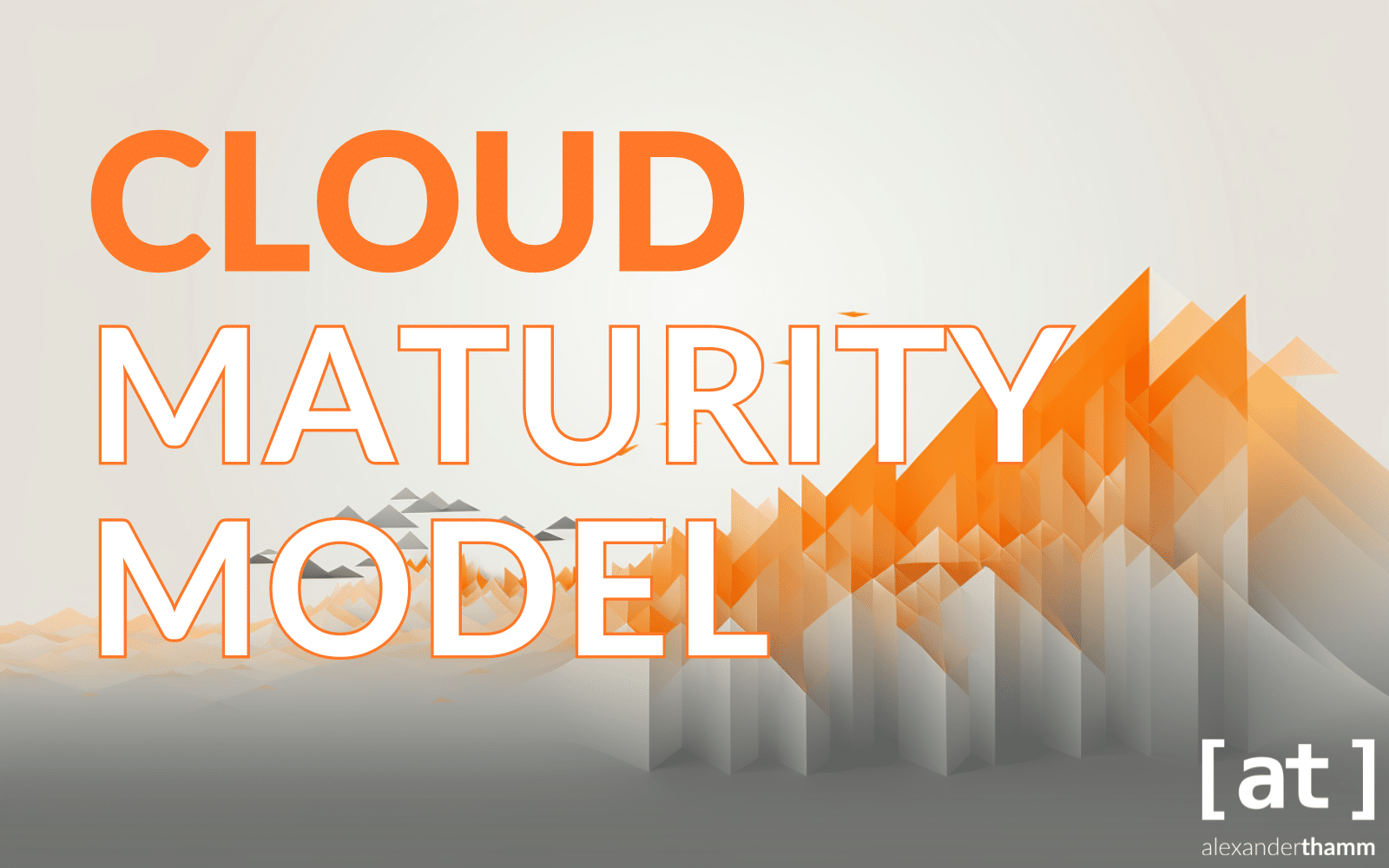Cloud computing technology has taken off in the last two decades, with organisations moving from legacy technologies to the cloud and building their entire infrastructure in the cloud. Over 40 % of the organisations surveyed by Fortinet are already hosting the majority of their workloads, while 58 % expect to reach this level within the next 12-18 months.
So what does a mature cloud mean in cloud computing? We can describe a mature cloud as a state where organisations have fully exploited the efficiencies and opportunities that cloud technology offers. A notable characteristic of cloud maturity is when a company has seamlessly integrated cloud services into its overall IT strategy and has achieved the desired level of optimisation, innovation and scalability that aligns with its business goals.
Inhaltsverzeichnis
What is the Cloud Maturity Model?
A cloud maturity model is a Framework that companies use to assess their cloud readiness. It assesses the current status of cloud implementation, compares it with the company's objectives and determines where the company needs to be.
The Cloud Maturity Model (CMM) enables organisations to create a blueprint for cloud adoption by identifying potential gaps, recommending relevant solutions and outlining the capabilities required to reach a certain level of maturity while addressing specific use cases.
Advantages of the Cloud Maturity Model (CMM)
The CMM has helped several companies to Cloud migration and improve cloud compatibility.
According to the 2023 State of the Cloud Report by RightScale 92 % of the IT decision-makers its importance for the company's success. The 2023 State of Cloud computing report from Flexera also emphasises the extent to which maturity models have become established: 78 % use them to drive the digital transformation forward.
To put all this into context, here are six advantages of the Cloud Maturity Model:
- Strategic orientation and objectives: The Cloud Maturity Model (CMM) enables companies to set clear goals and develop a convincing Cloud strategy to develop. Once a company has assessed its current maturity level, it can align its cloud initiatives with its overarching goals. This ensures a targeted and strategic approach to cloud integration.
- Definition of the maturity level and implementation of use casesThe model helps companies to determine the expected maturity levels and provides a structured framework for the implementation of cloud-based use cases. It starts with the level "We have just started using the cloud" and extends to the level "We have fully adopted the cloud". In this way, the cloud introduction can be customised to the specific business requirements and a step-by-step approach to the integration of cloud solutions can be ensured.
- Risk management and adoption of best practicesBy using CMM, organisations can adhere to best practices, identify relevant risks and proactively address challenges associated with cloud adoption. This holistic approach helps organisations to identify and mitigate potential cloud adoption pitfalls, thereby improving governance and the Cybersecurity situation.
- Improved cross-team communicationA CMM helps teams to clarify their strategy and feedback to stakeholders. It provides a common understanding of what everyone should expect and how the team intends to achieve its goals.
- Improved app and operational performanceIn the later phases of the Cloud Maturity Model, the focus is on improving the performance of all cloud-enabled and cloud-based applications. The CMM optimises processes and workflows so that companies can improve their responsiveness and efficiency in digital initiatives.
- Prioritising the introduction of cloud infrastructuresThe model enables companies to prioritise cloud-based computing initiatives. This facilitates a structured and strategic approach to the introduction of cloud computing. Cloud infrastructure. It also helps companies to allocate resources strategically while effectively migrating to cloud technologies.
- More secure and faster cloud adoptionThis is the most important point. CMM enables faster and more secure adoption of cloud technologies. It addresses risks and ensures compliance with best practices while taking a strategic approach. This enables organisations to manage the complexity of cloud adoption more confidently, ultimately leading to a safer and faster transition to the cloud.

Find out in our blog post how a comprehensive cloud strategy helps companies to achieve long-term goals and realise the full potential of the cloud
Cloud strategy: why companies need it and how to implement it
What is the CMM in terms of security and data governance?
A Cloud Security Maturity Model (CMM) evaluates and optimises the maturity level of an organisation in the management of Data governance and cyber security in a cloud computing environment. It offers a holistic approach to evaluating and improving good safety practiceswhich enables companies to analyse the complexity of protecting their applications and data in the cloud. The CMM usually consists of stages or phases. Each stage represents a different level of maturity in data management and security functions. Let's take a look at the components of the CMM.
Components of a cloud maturity model
| Component | Low degree of maturity | High degree of maturity |
| Security policies and procedures | Ad hoc or simple security policies and procedures | Comprehensive and well-documented safety policies that comply with industry standards, regulations and best practices |
| Access control and identity management | Basic access controls without sophisticated identity management | Advanced access controls, multi-level authentication and sophisticated identity management |
| Data encryption and data protection | Basic data protection measures and limited data encryption | Comprehensive encryption of data at rest and in transit as well as strict privacy protection measures |
| Incident response and threat detection | a reactive response to incidents, simple threat detection measures | a proactive approach to incident response, advanced threat detection systems and continuous monitoring |
| Compliance and harmonisation of legislation | Minimal compliance effort, limited focus on compliance and regulations | Compliance monitoring, strict adherence to industry regulations and audit readiness |
| Safety training and awareness | Limited cyber security training for the team | Ongoing and consistent security awareness training, programmes, pen tests and bug bounty to educate and empower the team |
| Data management and classification | inconsistent data governance practices | a formidable data governance framework as well as data classification and lifecycle management |

In our blog post, we explain the essential aspects of cloud security and data protection to keep your company safe in the digital cloud.
Interpretation of the topics of security and data governance in the CMM model
Risk assessment
Focus on securityAn important aspect of CMM is the systematic implementation of risk assessment and risk mitigation in relation to data processing and cloud services. This includes identifying vulnerabilities, assessing potential threats and implementing proactive strategies to improve the organisation's security posture.
Focus on data governanceA holistic assessment of risks in terms of data classification, access controls and data lifecycle management.
Access controls
Focus on securityAccess controls ensure that companies set up appropriate authorisation and authentication systems. This includes regulating user access to data, systems and applications to prevent unauthorised use and protect the corporate network from potential cyber security breaches.
Focus on data governanceThe focus is on aligning access authorisations with the classification and sensitivity of the data. This dual focus (security and data governance) ensures that access controls are robust both from a security perspective and with regard to the uniqueness and importance of the data.
Data encryption
Focus on securityThis involves the use of encryption algorithms to encrypt sensitive data in order to make it unreadable to unauthorised persons.
Focus on data governanceIntegration of encryption strategies with the principles of data governance. Organisations need to protect their data in line with cyber security best practices and regulatory requirements.
Response to incidents
Focus on securityThis includes developing incident response plans, setting up drills and implementing measures to rationalise the impact of security breaches.
Focus on data governanceThe focus is on the implementation of remediation strategies to restore security and manage potential compromise of sensitive data, as well as aligning incident response activities with data governance principles.
Compliance management
Focus on securityIt ensures that organisations have a strong focus on compliance with industry standards and regulations. This includes monitoring, evaluating and adapting best security practices to meet dynamic compliance requirements.
Focus on data governanceThe focus is on adapting data processing practices to the legal requirements.
Employee training
Focus on securityThis includes the training and awareness programmes and campaigns prepared to improve the human element of security. People are the biggest and the weakest link in cyber security.
Focus on data governanceDefinition and introduction of guidelines for the classification, ownership and management of data. This strengthens data governance frameworks and seamlessly integrates security considerations into data management practices.
Data Governance Framework
Focus on securityThis is about enforcing alignment between security measures and data governance principles in order to develop a coherent and holistic strategy for protecting data.
Focus on data governanceDefinition and implementation of guidelines for the classification, ownership and management of data.
Regardless of industry or company size, organisations can use the four levels and components of the CMM model to drive cloud adoption.

Data governance enables functioning frameworks and standards for the management, access control and use of big data to optimally exploit the potential of data analytics.
Data Governance: Fundamentals, Challenges and Solutions in Data Management
Four levels of the Cloud Maturity Model (CMM)
There are four main levels or stages of digital transformation in the cloud maturity model. Here they are:
Level 1: The initial or project maturity phase
This is the initial phase, which is usually referred to as the maturity stage. It marks the start of the digital transformation initiative. This phase is primarily about organisational planning and stocktaking. The reason for this is that at this early stage of cloud adoption, organisations feel the urge to explore the benefits of cloud services. Exploring basic services such as storage and compute with a basic understanding of cloud dynamics often leads to further exploration. On the other hand, the challenges at this stage are managing costs and ensuring basic organisational security and awareness.
Level 2: Laying the foundation stone or the youth stage
The second stage of the cloud maturity model is the youth stage, where cloud exploration continues. Once the organisation has left the early stage behind, it deepens its exploration towards higher workloads. At this stage, navigation of the cloud terrain is more fluid in order to better optimise the company's cloud usage. In this way, the organisation is moving from tiptoeing towards adopting more important services such as database management and serverless computing. Unfortunately, fine-tuning performance metrics for specific workloads is a major challenge. In addition, scalability management and regulatory compliance pose further challenges at this stage. This can also impact the return on investment for a successful outcome.
Level 3: The migration or adult phase
In this phase, the entire organisation is moved to the cloud, which we know as cloud-based. It can also include the migration of all applications to the cloud. In the third stage, companies can utilise advanced cloud features such as the Internet of Things, machine learning and analytics. Despite the great progress made in this phase, it is not without its challenges. For example, governance, cost management for complex architectures and integration with existing systems are potential challenges. Even if the company has a clear plan, it may still encounter challenges during implementation. However, every success achieved in this phase positions the company for a leading role in the technology industry.
Level 4: The optimisation or expert level
When a company reaches this stage, it begins to operate with unrivalled agility. This is because they can navigate through the implementation of cutting-edge technologies in multi-cloud environments. This allows the company's digital transformation to continue thanks to the optimisation of the cloud infrastructure. Successful entry into this phase enables companies to distinguish themselves as innovators and pacesetters for technological excellence. Challenges in this phase include keeping pace with and adopting new technologies, optimising for excellence and staying ahead of the curve.
These four stages of the cloud maturity model represent the journey through the technological development of companies towards utilising the potential of cloud computing.

Cloud computing enables companies to use their IT resources more flexibly and cost-efficiently. The cloud architecture and infrastructure play a central role in this. Find out which aspects you need to pay attention to in our blog post:
Cloud Computing - Architecture & Infrastructure: Compactly explained
A model for a sustainable cloud strategy
The Cloud Maturity Model (CMM) is a valuable framework that enables organisations to navigate the dynamic landscape of cloud adoption. This article helped me understand what the CMM is and how it works. It also highlighted the inherent benefits for organisations looking to improve their cloud strategies. The importance of this model goes beyond cost savings and efficiency. It also includes the creation of solid security and alignment with data governance regulations. This allows organisations to develop a mature awareness of compliance and risk management as they progress through the four levels of the model.











0 Kommentare